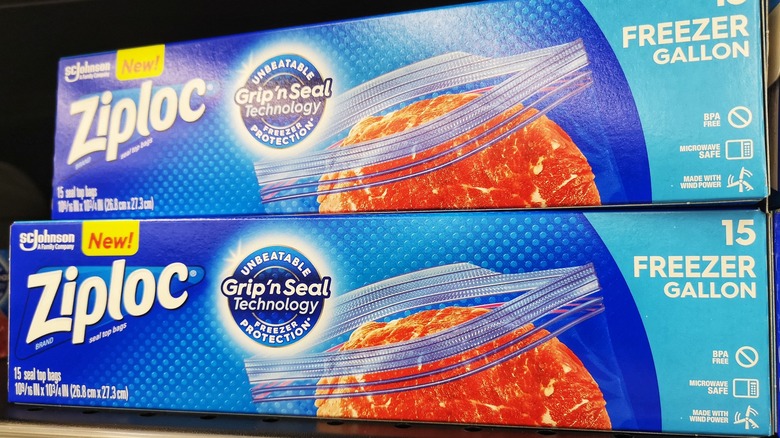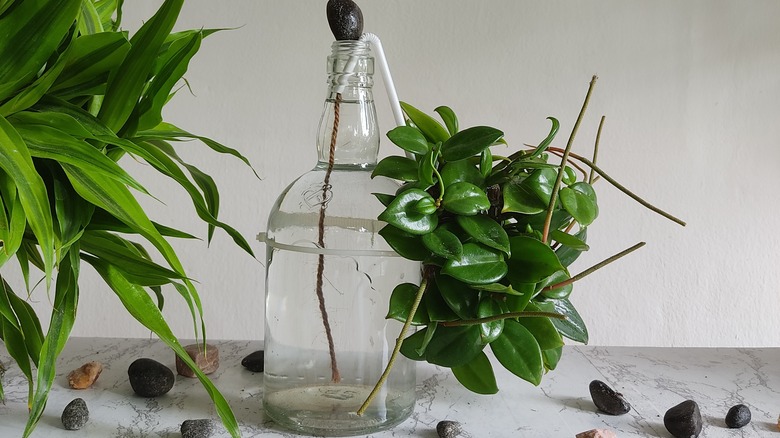How To Turn A Ziploc Bag Into A Simple Self-Watering Planter
Do you worry about keeping your indoor plants alive while on vacation? How are you supposed to keep them happily watered if you don't have anyone to house-sit your plants while you're gone? A simple self-watering planter can be constructed from a Ziploc bag and just a few additional items, including, but not limited to, a string and clothespins. These items can also be substituted for others that accomplish the same function. Get creative if needed! And, you're obviously going to need some water.
First, clip your Ziploc bag to the side of your potted plant using clothespins or any substitute to keep the bag from falling over or spilling once filled. Next, place one end of your cotton string in the Ziploc bag and bury the other in the soil of your potted plant. Lastly, fill the bag with water and seal the bag around the string to prevent unwanted evaporation. The string will immediately begin to soak up water, and the soil will absorb water from the string. As the plant continues to absorb water from the soil, further moisture will be added from the Ziploc bag through a phenomenon called capillary action which occurs in the string.
Creating your self-watering system and how it works
To understand this how this self-watering planter works, you need to understand capillary action. The process occurs when the adhesive and cohesive properties of water allow it to climb up or soak through some structures, such as thin tubes or spongy materials. Capillary action is how plants carry water from their roots up into their extremities. As water evaporates from plant leaves, water's properties allow it to push out of the stem. Which leaves room for water to draw out of the roots, and from the soil into the roots. In your new self-watering system, as water soaks into the roots of your plant, water in the string will move into the soil using the same mechanism. In turn, there will be more room for water to soak into the string from the Ziploc bag. The process will continue and the water level should decrease in your bag.
It's important to note that this DIY solution only works for plants that thrive in continuously moist soil. This method might not benefit plants that are drought-resistant or enjoy well-drained or occasionally dry soil, such as houseplants that you barely need to water. This simple DIY gadget will likely keep the soil continuously moist, so consider your plant's moisture preferences. As the plant consumes more water and the soil loses moisture through evaporation, the system will continue to add water to the soil.
Important considerations and alternatives
To take advantage of capillary action, an absorbent cotton string should be used. However, a lengthy rolled-up piece of cotton cloth could also be a good substitute. But also consider that cotton is an organic material which means it can rot or get moldy. If you frequently reuse your self-watering planter, it is a good idea to occasionally replace your cotton strings or instead use a non-organic material such as polyester to prevent rot and mold growth. However, polyester might be less absorbent.
Depending on the size of your potted plant, you may need multiple strings leading from your water bag that are evenly distributed throughout your soil. One string will not be enough for a pot larger than just a few inches in diameter. You can also adjust the number of strings depending on the plant's preference for moisture. More string means less time to absorb moisture and a more even moisture distribution. Also consider how long you'll be absent. Where some plants may need a small Ziploc bag, others may need the gallon-sized bags.
Additionally, a Ziploc bag and string aren't the only tools. The bag can be substituted for any container. You could even use a vase to create a self-watering planter. You could also experiment with a plastic water bottle. Just poke holes in the cap and press the capped side into the soil. This might lead to more water flow to the soil, so the plant's moisture preference should always be considered.

